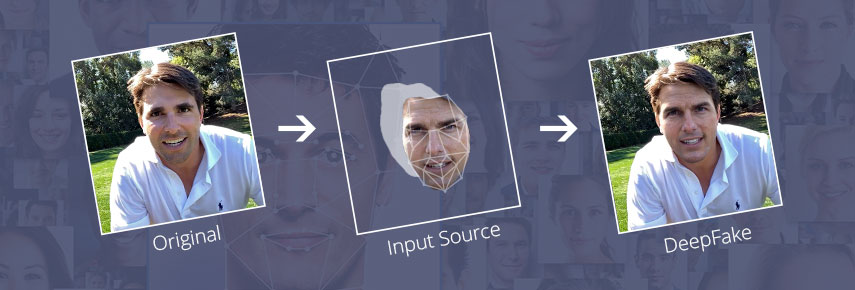Deepfakes – The Terrifying Technology You Probably Haven’t Heard Of
In the spirit of Halloween this Sunday, we thought it was time to look at one of the most unnerving technologies of the 21st century – deepfakes.
What is a deepfake?
Using an aspect of artificial intelligence known as deep learning (an offset to machine learning), a person can manipulate media into reflecting someone else’s face. Recently, technology has also been developed and is being used to create deepfake audio – the ability to accurately fake a person’s voice.
In order to fully grasp the concept of a deepfake, let’s look at the aspects of artificial intelligence that are involved in building one. Machine learning is the umbrella term, so we’ll start there. Machine learning allows software to self-improve its accuracy when predicting outcomes – and it does this without being programmed to. Instead, the software relies on historical data as its input to predict the output value. A great example of an everyday software that uses machine learning is Google. Google’s algorithms are based in machine learning, so that when you type in the search bar, it can offer helpful suggestions as to what you may be looking for. The type of historical data Google can use for this are past searches, the most popular searches related to your search, and your location.
More specifically, a deepfake uses a branch of machine learning called deep learning. Deep learning uses the same sort of machine learning algorithms, but they are structured in a more brain-like format, known as artificial neural networks. Someone creating a deepfake first must spend hours “training” this artificial network to understand how their target looks e.g., from different angles, or in low light compared to natural or bright light. This is done through using hours of video footage of their target. This network is then meshed with computer graphic techniques (an example being 3D face mapping) to overlay the deepfake onto an actor. The result is usually massively convincing, and it’s only becoming easier to do. Deepfake technology has been described as having a “democratised access”, anyone is able to go onto the internet and download software that is similar to that used in Hollywood. The ease of access and simplicity of the technology is what governments, academics, and professionals around the world are worrying about. There are entire websites dedicated to having someone design your own personal deepfake. These sites are essentially a marketplace and forum for tutorials and commissions – anything goes behind the scenes; even the website creators and moderators are unaware of what occurs in users’ private messages.
The dangers of deepfakes
Authorities are already seeing a rise in complaints related to deepfakes. 96% of deepfake videos on the internet are non-consensual explicit videos, in which the victim’s face is superimposed onto the actor/actress. Despite this, a majority of countries around the world have little legislation in place to protect these victims. Many professional women – such as investigative journalist Rana Ayyub – have had their names and reputations almost irreparably damaged as a result of deepfakes. In Rana Ayyub’s case, the United Nations had to step in to mitigate the online abuse she was receiving.
Furthermore, the increasingly realistic quality of these videos could potentially begin an epidemic of false memories of politicians, celebrities, and other cultural figures saying or doing something that never happened. Take a look at the video of “Mark Zuckerberg” created for Spectre by Bill Posters and Daniel Howe. The deepfake of Zuckerberg featured in the clip reveals that he has access to everyone’s data, and whoever holds all of this information has the power to control the future – an extremely unnerving point considering Facebook’s ongoing privacy saga. Another example of a well-viewed deepfake is the “Donald Trump” video circulated by Belgian political party The Flemish Socialist Party that depicts the former US president calling out Belgium for not withdrawing from the Paris Agreement. While these videos have, of course, been widely debunked, there’s no telling the impact these videos and others could have had if the creators hadn’t confirmed they were deepfakes.
What should we look for?
As mentioned before, the quality of these deepfakes is only improving as the years continue. In the older videos or videos created with less time spent on them, look for seams or blurring around the jawline, hairline, and by the ears. This is where the superimposed image of the face hasn’t been meshed flawlessly with the actor’s underneath. Also, look for the face “slipping” when the actor turns their face away from the camera, it’s difficult to capture a face at all angles – videos that are created in a rush are often susceptible to this.
There are also other signs that you can look out for, but they require some more concentration and awareness. Look at the hair on the person in the video. Is it moving in a way you perceive to be natural? In HD quality videos, is there frizz or flyaways? Computer generated images rarely are able to capture this level of detail without the creator having a serious level of experience. You can also take a look at the eyes of the person. Are they blinking regularly, if at all? Are the eye movements being made jerky or in any way unnatural? It is very difficult to replicate blinking and eye movements in a lifelike and natural way, especially if the creator has little experience. Unfortunately, in an age where technology is progressing faster than we can keep up, we have to rely on others making mistakes and cutting corners.
We hope this has been an informative (if a little eerie) post. Let us know your opinions about deepfakes in the comments!

No comments for "Deepfakes – The Terrifying Technology You Probably Haven’t Heard Of" yet, why don't you let us know what you think.
Leave a Comment
Your email address will not be published. Required fields are marked *